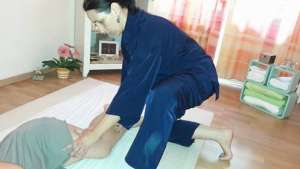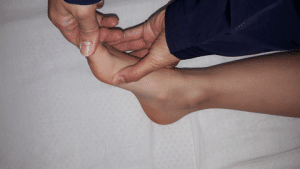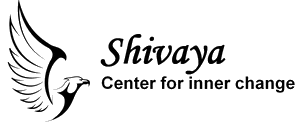Shiatsu
“… I think it is not our right but our duty to be healthy.”
Shizuto Masunaga
Shiatsu is the art of well-being which is accessible to all!
Shiatsu is a manual therapy developed in Japan in the beginning of the 20th century.
It is a type of medical treatment. It is based on the theoretical framework of traditional Chinese medicine, on the concept of Tao, Yin and Yang and on the 5 elements.
One of the fundamental concepts is Qi (pronounced “chee”). This is the vital energy in our body that underlies all functioning. When the Qi becomes deficient or its flow is obstructed, symptoms arise. Shiatsu stimulates and harmonizes the flow of Qi throughout the body.
How does Shiatsu work and what are the benefits?
It supports and strengthens the body’s natural ability to heal and balance itself.
 Actually, Shiatsu is a holistic therapy that works on physical, psychological, emotional and spiritual level. It harmonizes the body and the mind.
Actually, Shiatsu is a holistic therapy that works on physical, psychological, emotional and spiritual level. It harmonizes the body and the mind.
It stimulates the blood circulation, the nervous system as well as the hormonal and immune systems.
It provides well-being, physical and mental health and heals many diseases.
In addition, Shiatsu provides a real moral support. It allows people to identify their emotions and to be attentive to their needs.
The practice of Shiatsu reduces stress, eliminates tension factors and promotes well-being, relaxation, balance, harmony of body and mind.
The goal of Shiatsu is to correct the internal malfunction and to heal using the natural healing power of the person.
Pathologies
- Back pain, osteoarthritis, arthritis, etc.
- General fatigue
- Headache
- Sleeping troubles
- Sexual disorders
- Digestive disorders (colitis, constipation, vomiting, bloating …)
- Muscle tension
- Joint pain
- Difficulty breathing (asthma, colds, sinusitis, allergy)
- Water retention in tissues
- Psychological disorders such as stress, depression, anxiety, addictions, phobias, nervousness, obsessive compulsive disorder, etc…
What happens in a Shiatsu session?
 It is better if you wear light and comfortable clothing. Shiatsu is practiced on a mattress on the floor. In the beginning of the session the practitioner makes a health assessment. Afterwards he performs pressure on a series of specific points (tsubos) along the meridians.
It is better if you wear light and comfortable clothing. Shiatsu is practiced on a mattress on the floor. In the beginning of the session the practitioner makes a health assessment. Afterwards he performs pressure on a series of specific points (tsubos) along the meridians.
The practitioner may use a variety of manual techniques in order to access the vital Qi.
The literal translation of Shiatsu is ‘finger pressure’, but he may apply pressure with fists, elbows or knees depending on the degree of blockage.
The session often ends with a moment of rest.
No massage oil is required and a session lasts about 1,5 hours.
Precautions to take
Shiatsu does not pose any risk. However, it may be harmful for a person in case of open wounds, inflammation, contagious skin infections, bleeding, ulcers, fever, acute cardiac disorders or after surgery
*In 1955, the Japanese Ministry of Health officially recognized Shiatsu as a preventative and therapeutic method.
In May 1997, the European Union mentioned it as one of the 8 complementary and alternative medicine recognized in its 28 member states.
* Shiatsu is not a substitute for medical diagnosis or treatment.
How Much Does Shiatsu Cost?
*Included in the price: nutritional advices and stretching exercises
Shiatsu FAQ
Frequently Asked Questions About Shiatsu
“Shiatsu is like massaging your entire being – your body, your mind, and your spirit. These parts of you are all interconnected, and affect each other when things get out of balance. Shiatsu feels great on the body, with the added benefits of calming the mind and smoothing out the emotions.”
If you have any other questions that are not answered here, please do not hesitate in contacting me.
Shiatsu is a Japanese manual therapy based on traditional oriental healing principles and modern anatomy and physiology theory. Literally translated as “finger pressure”, Shiatsu consists of simple manipulations and pressure applied to acupuncture meridians and points. Shiatsu aims to assist the body’s natural healing process by encouraging the client’s energy to move into a balanced state.
No. Shiatsu is a customized therapy. The treatments are different every time, and reflect the needs of your body at the time of the treatment.
For chronic conditions, 5 or 6 treatments are usually needed to feel some benefit. For more general health and wellbeing, an occasional shiatsu is fine.
No. You can receive Shiatsu for relaxation. Regular treatments may help to keep the body in harmony and good health.
Yes. Shiatsu can offer support and can often help to moderate symptoms even if the problem will never disappear. Shiatsu may boost tolerance levels in the receiver, helping them to deal with the symptoms.
In Shiatsu diagnosis plays a central role, but it is framed in terms of oriental medicine (Qi, the 5 elements, meridians, etc.). The practitioner may be able to tell you that you have, for instance, a Water energy imbalance, but not that you have diabetes or high cholesterol. Shiatsu diagnosis is holistic rather than analytical, taking into account a wide range of clues based on what the client says, observation of behaviour patterns and physical appearance, and touch. In general the session begins with gentle palpation (i.e. diagnostic touch) of the abdominal region. This region, called the Hara in Japanese, is especially important in diagnosis.
Shiatsu is not appropriate in case of:
Locally:
- Broken bones
- Open wounds and lesions
- Burns
- Rashes, poison oak/ivy, hives
- Psoriasis is NOT a contraindicated condition, however, avoid “breaks” in the skin (legions)
- Shingles
- Fungus i.e. nail fungus, athlete’s foot
- Varicose veins
- Inflammation
General:
- High Fever
- Intoxication (drugs or alcohol)
- Contagious diseases, such as, chicken pox, measles, severe flu or shingles
- High risk pregnancies
- Blood cancers, like leukemia
There are no age limits, from baby to end of life.
Shiatsu is complementary, not an alternative to Western medicine. Treatment will be given according to Oriental diagnosis, though it is always important that the modern Western diagnosis is confirmed and considered as well. Both Shiatsu and Western medicine have important roles to play.
Shiatsu can be viewed as self-development process as well as therapy. You can learn more about the way your body works, and how intimately your physical health is linked to thoughts, emotions and feelings.

